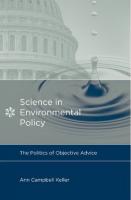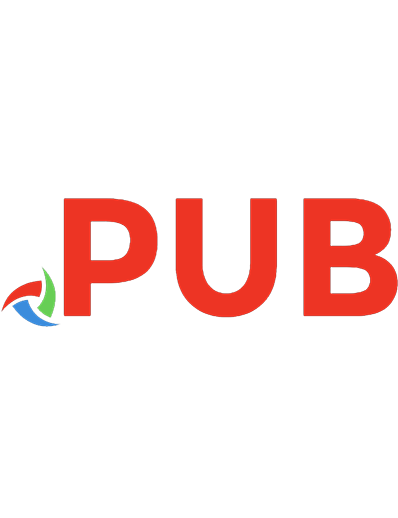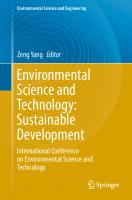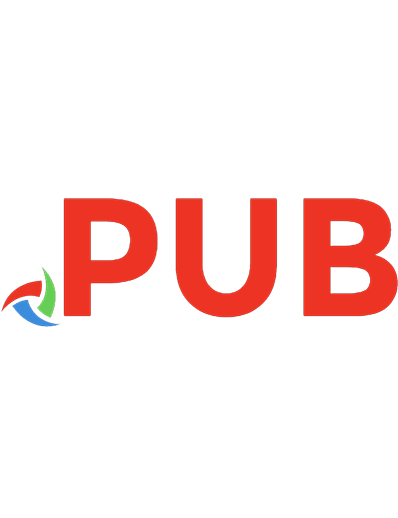Environmental science 9781306319065, 1306319064, 9781315838205, 1315838206, 9780582416208
820 244 8MB
English Pages 515 [517] Year 2013
Polecaj historie
Table of contents :
Content: Section 1. Heat and thermal effects --
section II. Sound --
section III. Light --
section IV. Fire --
section V. Climate effects.
Citation preview
Environmental Science B. J. S m ith, G. M. P h illip s 6t M. S w een ey
This page intentionally left blank
^
H
B
B. J. Smith B.Sc., Ph.D., F.C.I.O.B., F.C.I.B.S., C.Eng., M.InstP., F.I.O.A., F.I.M.A. F.B.I.M.
G.
M . Phillips
B.Sc., M.Sc., C.Eng„ M.C.I.O.B., M.C.I.B.SE., M.1.0A
M . E. Sw eeney B.Sc., M.Sc.
Environmental science
R
Routledge Taylor & Francis Group
LONDON AND NEW YORK
First published 1983 by Addison Wesley Longman Limited Published 2013 by Routledge 2 Park Square, Milton Park, Abingdon, Oxon 0X14 4RN 711 Third Avenue, New York, NY 10017, USA Routledge is an imprint o f the Taylor & Francis Group, an informa business Copyright © 1982, Taylor & Francis. All rights reserved. No part of this book may be reprinted or reproduced or utilised in any form or by any electronic, mechanical, or other means, now known or here after invented, including photocopying and recording, or in any information storage or retrieval system, without permission in writing from the publishers. Notices Knowledge and best practice in this field are constantly changing. As new research and experience broaden our understanding, changes in research methods, profes sional practices, or medical treatment may become necessary. Practitioners and researchers must always rely on their own experience and knowl edge in evaluating and using any information, methods, compounds, or experi ments described herein. In using such information or methods they should be mindful of their own safety and the safety of others, including parties for whom they have a professional responsibility. To the fullest extent of the law, neither the Publisher nor the authors, contributors, or editors, assume any liability for any injury and/or damage to persons or property as a matter of products liability, negligence or otherwise, or from any use or opera tion of any methods, products, instructions, or ideas contained in the material herein. ISBN 13: 978-0-582-41620-8 (pbk)
British Library Cataloguing in Publication Data Smith, B.J. Environmental science. - (Longman technician series. Construction and civil engineering) 1. Human ecology I. Title II. Sweeney, M. E. III. Phillips, G. M. 333.7 GF41
Contents Preface viii A cknow ledgem ents List o f units x
Section I
ix
Heat and thermal effects 2
Chapter 1 Thermal transmission T em perature 2 Q uantity of heat 3 Transm ission of heat energy 5 Therm al properties of construction m aterials 32 Therm al insulation of construction m aterials 36 Therm al insulation of structural com ponents 38 H eat loss 52 H eat gain 65 Q uestions 78
Chapter 2
Chapter 3
83
Thermal comfort
A ir tem perature 83 M ean radiant tem peratu re 84 A ir m ovem ent 85 A ir/m oisture m ixture and its assessm ent The psychrom etric chart 97 V entilation 104 H um an com fort 105 A ir conditioning 110 Q uestions 112
Condensation
C ontrol of condensation Q uestions 141
114
87
114
Section II Chapter 4
Sound Sound and its measurement
146
The nature and propagation of sound waves 146 M easurem ent of sound intensity and loudness 150 E xperim ents 169 Q uestions 196
Chapter 5
Room acoustics
197
R equirem ents for good room acoustics A bsorption of sound 197 R everberation 206 Experim ents 216 Q uestions 236
Chapter 6
Transmission of sound
Propagation of sound in open air Reduction by barriers 242 Sound insulation 249 Experim ents 267 Q uestions 273
Chapter 7
Chapter 8
238
238
The effects of noise on man
H earing sound 275 Noise criteria 285 The steps in a noise control program m e Q uestions 302
Section III
197
275
299
Light Artificial lighting
Term inology and units of illum ination 305 Artificial lighting calculations 310 D irect com ponent of illum inance 310 Indirect com ponent of illum inance 315 The lum en design m ethod 316 Perm anent supplem entary artificial lighting of interiors (PSA LI) 339 Experim ents 342 Q uestions 357
305
vii
Chapter 9
Daylighting
Introduction 361 Daylight factor 366 Prediction m ethods 374 Daylighting recom mendations Experim ents 409 Questions 410
Chapter 10
361
405
411
Illumination for human comfort
Light and the eye 411 Glare and its control 417 Visual acuity 435 Visual fatigue 438 Conditions necessary for good illumination Questions 445
439
Section IV Chapter 11
Fire
448
Introduction 448 Calorific values of common building materials 449 Fire tests on building materials and structures 450 Growth and decay cycle of fires 455 Fire load and fire density 456 Fire gradings 458 Properties of building m aterials at high tem peratures Factors affecting the spread of fire 460 Behaviour of smoke 461 Experim ents 463 Questions 467
458
Section V Chapter 12
Climate effects
Wind speed 470 Exposure of a structure to the elem ents The microclimate 481 Questions 481 Answers 483 Bibliography 488 A ppendix 493 Index 495
470 476
Preface In w riting this book th e au th o rs aim ed to cover th e requirem ents for the Business and T echnician E ducation C ouncil Level T hree & F our U nits in E nvironm ental Science. At th e sam e tim e it was recognised th at there was a real need for a suitable book fo r those studying Building, Q uantity Surveying, A rchitecture an d E nvironm ental H ealth at 1st degree level. T his book should therefore form a useful first year introductory text fo r b oth ‘A’ level and BTEC entran ts. T he b ook contains a large n u m b er o f w orked exam ples in th e text as well as m any stu d en t q uestions at th e en d o f each ch ap te r. E xperim ents have b een included, n o t w ith th e in ten tio n o f being exhaustive, but to give ideas. Som e areas o f w ork lend them selves to stu d en t practical w o rk b e tte r th an o th ers so th a t som e in balance is inevitable. ‘E n v iro n m en tal Science’ should give stu d en ts an in tro d u ctio n to th e environm ental pro b lem s in construction an d th e m eth o d s w hich m ay be used to provide a satisfactory and econom ic solution.
Acknowledgements W e are grateful to the following for perm ission to reproduce copyright m aterial: British Standards Institution for our Fig. 9.18 and our Table 9.15 from CP 3 C h ap ter 1, P art 1, 1964; our Table 3.1 from B S 5250, 1975; Building E stablishm ent, D ep artm en t of the E nvironm ent for our Fig. 9.12 from Fig. 1 B R S Daylight Factor Protractors', our Fig. 9.17, o u r Table 9.4 from Table 1, our Table 9.5 from Table 2 and our Table 9.10 from Table 3 B R S Digest, 42 by perm ission of the C ontroller of H e r M ajesty’s Stationery Office; The C hartered Institution of Building Services for our Fig. 8.15 from Fig. 8 C IB S (IES) Technical Report N o 2; our Fig. 9.3 from Fig. 11, our Fig. 9.13(a) and (b) from Fig. 3, our Figs. 9.7, 9.8 and 9.9 from T able 7, our T able 10.4 from T able 1, our Table 10.5 from Table 2 and our Fig. 10.9 from C IB S (IES) Technical Report No. 4; our Table 10.2 from T able 1.8, o u r Table 10.1 from Table A1 and our Fig. 10.8 from Fig. 2 C IB S (IES) Technical R eport No. 10; our Figs. 9.1 and 9.2 from Fig. 1 C IB S (IES) Lighting Guide-, our Table 2.1 from C IB S G uide, Section A l; o u r Fig. 8.11 from Fig. 32, our Fig. 10.7 from Fig. 16, our Fig. 10.14 from Fig. 3, our Fig. 10.6 from Fig. 7 and our Tables 8.2 and 9.14 from C IB S (IES) Code fo r Interior Lighting 1977; o u r Fig. 10.17 from Fig. 14 C IBS (IES) Code fo r Interior Lighting 1977 and Fig. 16 C IB S (IES) Code fo r Interior Lighting 1973; our Figs. 10.12 and 10.13 reproduced from the pap er ‘Eyestrain: the environm ental causes and their p revention’ by J. H . G oacher C IB S National Lighting Conference 1980; Lighting Industry Federation L td for o u r Fig. 10.4 from fig p 30 Interior Lighting Design-, Longm an G roup L td for our Table 9.2 from Table 6.6, our T able 9.3 from Table 6.8, o u r Table 9.6 from Table 6.7, o ur T able 9.11 from Table 6.5, our Fig. 9.10 from Fig. 6.6, our Fig. 8.22 from Fig. 6.8 and o u r Fig. 10.2 from Fig. 1.6 Lighting (2nd edn) by D . C. P ritchard, E nvironm ental Physics Series; A . M. M arsden and T horn Lighting Ltd for our Fig. 10.5 from Fig. 2.5 Lam ps and Lighting by H enderson and M arsden published by E dw ard A rnold.
List of units T here are three classes of SI U nits (Système International d ’U nités, o r International System of U nits): 1. 2. 3.
Base units Supplem entary units D erived units
1
Base units
Quantity
Name o f unit
Symbol
length mass time electric current therm odynam ic tem perature lum inous intensity am ount of substance
m etre kilogram second am pere kelvin candela mole
m kg s A K cd mol
Quantity
Name of unit
Symbol
plane angle solid angle
radian steradian
rad sr
2
3
Supplementary units
Derived units
Quantity
Name of unit
Symbol
Relationship to base or supplementary unit
frequency force pressure or stress w ork, energy, quantity of heat
hertz new ton pascal
Hz N Pa
1 Hz = 1 s_1 1 N = 1 kg m s-2 lP a = l N m '2
joule
J
1J= 1N m
xi Quantity
Name of Unit
Symbol
Relationship to base or supplementary unit
pow er quantity o f electricity electrical p o ten tial, p o ten tial difference, electrom otive force electrical resistance electrical capacitance inductance lum inous flux illum ination
w att coulom b
W C
1 W = 1 J s“ 1 1 C = 1 As
volt ohm farad henry lum en lux
V n F H lm lx
1V= i n = 1F= 1H = 1 lm = 1 lx =
1 W A -1 i v a -1 1 A sV -1 1 V s A '1 1 cd sr 1 lm m -2
M ultiples Name
Symbol
Factor
tera giga m ega kilo hecto deca deci centi milli micro nano pico fem pto atto
T G M k h da d c m
IO12 IO9 IO6 IO3 IO2 10 IO“ 1 i o -2 IO-3 IO "6 IO“ 9 IO-12 IO "15 10-18
n P f a
It is p referab le to express all values so th a t a n u m b er betw een 0.1 and 1000 can be w ritten dow n for th e q uantity.
Examples of units Quantity
SI units
Multiples
p lane angle length area volum e tim e
ra d m m2 m3 s
m rad , rad k m , cm , m m , /xm , nm km 2, dm 2, cm 2, m m 2 dm 3, cm 3, m m 3 ks, m s, ¿is, ns
xii Examples of units (Cotit.) Quantity
SI units
angular velocity velocity acceleration mass density m om entum m om ent of inertia force m om ent of force pressure stress
ra d /s m /s m /s2 kg , k g /m 3 kgm /s kgm2 N Nm
Pa
P a, N /m 2
surface tension heat, energy, w ork pow er, heat flow rate Celsius tem perature tem perature interval linear expansion coefficient therm al conductivity heat capacity specific heat capacity specific latent heat electric current electric charge quantity of electricity potential difference capacitance resistance resistivity
N /m J W
wavelength radiant energy lum inous intensity lum inous flux quantity of light lum inance illum inance sound pow er level sound pressure level
m J cd lm lm s c d /m 2 lx dB dB
sound reduction index reverberation time
dB s
Multiples
Mg, g, m g, fig
M N, kN , m N , ¡mN G Pa, M Pa, kPa, m Pa, /xPa G P a, M P a(N /m m 2), kPa, m Pa, ¿¿Pa m N /m M J, kJ M W , kW , mW , jaW
°c K K -1 W /(m K ) J /K J/(k g K ) J/k g A C V F
n flm
k J/K k J/(k g K ) M J/k g , k J/k g kA , m A ; fiA , nA , pA kC, ¿iC, nC, pC M V, kV , m V, fiV m F, /xF, nF, pF G ÎÎ, M iì, k ii , m ii, ¿ifi G iìm , M ilm , k fìm , flc m , m ftm , /xflm , n iîm nm , pm
(R eference level 10 ~n W) (R eference level 2 x 10“ N /m 2)
Section I
Heat and thermal effects
Chapter 1
Thermal transmission Temperature H eat is associated with the continual random motion of molecules within all states of matter - solid, liquid and gas. Temperature is a measure of this molecular energy. The transfer of heat energy to or from a body is dependent upon tem perature. If a cold body at a low tem perature is placed in contact with a hotter body at a higher tem perature, heat is transferred from the hotter body to the cold body until thermal equilibrium is estab lished and both bodies are at the same temperature. If no heat flows upon contact, there is no difference in tem perature. The establishment of a tem perature scale requires fixed points at which the tem perature is always the same and reproducible. Any property of a substance which changes with tem perature, such as length, volume, resistance or thermoelectric electromotive force can be used for tem perature measurement. Thermodynamic temperature scale The basic tem perature is the thermodynamic temperature (T) in kelvin (K). The unit of thermodynamic tem perature, the kelvin, is the fraction 1/273.16 of the thermodynamic tem perature of the triple point of water (approximately 0°C). The triple point of water is the tem perature at which ice, water and water vapour coexist in equilibrium at a pressure of 610 N /m 2.
3 C elsius tem perature scale Practical tem perature m easurem ents are usually m ade in degrees Celsius (°C). O n the Celsius scale of tem perature the lower fixed point is the tem peratu re of melting ice at standard atm ospheric pressure (101.325kN /m 2) and is defined as 0°C. The upper fixed point is the tem perature of steam above w ater boiling at standard atm ospheric pressure and defined as 100 °C. M easurem ents show that 0°C = 273.15 K 100 °C = 373.15 K H ence an interval or change of 1 °C on the Celsius scale has the same m agnitude as an interval or change of 1 K on the kelvin scale. 6 or t denote tem perature on the Celsius scale (°C), and T denotes tem perature on the therm odynam ic and absolute scales (K). Since 0°C = 273.15 K T = 273.15 +
6
so that 21°C = 273.15+ 21 = 294.15 K Sufficient accuracy is usually obtained by writing 273 for 273.15, so that approxim ately, 21 °C = 273 + 21 = 294 K (Fig. 1.1)
Quantity of heat H eat is a form of energy. Q uantity of heat is m easured in term s of the fundam ental energy unit, the joule (J). The joule is defined as the work done when the point of application of a force of 1 new ton (N) is displaced through a distance of 1 m etre (m) in the direction of the force. A new ton is th at force which applied to a mass of 1 kilogram (kg) gives it an acceleration of 1 m etre per second per second (m /s2). The application of heat to a body may result in a rise in tem perature o r a change in state. Sensible heat is a term som etimes used in heating and cooling to indicate any quantity of heat which changes only the tem peratures involved. The heat energy used to change the state of a substance is known as the latent heat. Sensible heat T he specific heat capacity (c) is the h eat required to raise the tem p erature of unit mass (1 kg) of a substance by 1 K.
4
The term heat capacity or therm al capacity o f a body is defined as the quantity of h eat required to raise the tem perature o f th a t body by 1 K. The therm al capacity, often useful as a m easure of the heat storing capacity o f an elem ent or structure, is obtained from the product of mass and specific h eat capacity: therm al capacity = mass x specific h eat capacity (J/K ) (kg) (J /k g K )
The quantity of heat required to produce a temperature change in a body of mass m with specific heat capacity c is given by quantity of heat = where, and
6
mcO
= mass (kg) c = specific heat capacity (J/kg K) 6 = temperature difference (K)
m
Example 1.1 Calculate the quantity of heat required to raise the temperature of 0.2 kg of water from 15 °C to 90 CC if the specific heat capacity of water is 4.2kJ/kgK . 0.2 kg c = 4.2 k J/k g K = 4.2 x 1000 J/k g K = 4.2 x 103J/k g K
m=
Temperature rise required,
d
= 9 0 -1 5 = 75 °C Quantity of heat = me 6 = 0.2 x 4.2 x 103 x 75 = 63 x 103J Quantity of heat = 63 kJ
Latent heat When heat is supplied to a body at its melting or boiling point there is no temperature change. The latent heat is the quantity of heat required to change the state of a substance without change of temperature. The heat required to change a solid to a liquid at the melting point is called the latent heat of fusion. The heat required to change a liquid to a gas at the boiling point is called the latent heat of vaporisation. The specific latent heat is the quantity of heat required to change the state of unit mass (1 kg) of a substance, without change of tem perature.
Transmission o f heat energy Heat energy transmission takes place from a higher temperature region to one at a lower temperature. This heat energy transfer may
6 be by one or m ore th an one of th ree modes: conduction, convection, and radiation. C onduction Conduction of therm al energy may take place in all th ree states of m atter - solid, liquid, gaseous. T he kinetic energy o f molecules within a body may be associated with the tem perature o f th a t body. A n increase in tem p eratu re corresponds to an increase in the energy and hence the activity of molecules within the body. These m olecules are not isolated but interact with on e another. T he transfer of therm al energy takes place as a result o f interactions betw een higher energy molecules and ones of low er energy. T herm al energy trans ference by conduction is in the direction o f decreasing tem peratures and involves a continuous gradient of tem perature throughout the body. In the solid state m olecules are closely packed together at fixed positions within the solid. M ose molecules do n ot move throughout the solid but vibrate and ro ta te at th eir ow n position in th e solid. If therm al energy is supplied to one region of the solid, the molecules in that region becom e h otter, m ore energetic, vibrate and ro tate m ore rapidly and interact with neighbouring m olecules so th at this excess energy is soon shared w ith the neighbouring m olecules, which in turn share their increase in energy w ith th eir nearest neighbours. The heat energy is transm itted from m olecule to m olecule th roughout th e w hole solid. Liquid m olecules are closely packed together, b ut do not have the fixed positions of solid m olecules. T he molecules move in random fashion in the liquid. In this continuously changing arrangem ent of m olecules therm al energy transfer and hence heat conduction take place less rapidly than in m ost solids. T he m olecules in a gas are relatively far ap art and m ake random collisions with each o th er and the walls o f th eir container. T he wide separation betw een gas molecules leads to few er m olecular collisions than in liquids, and hence less efficient therm al energy transfer th an in liquids or solids. Conduction is the transfer o f therm al energy by m olecular interactions, from on e part of a body to an o th er under the influence of a tem perature gradient, w ithout appreciable disturbance of the usual m olecular arrangem ents within the body. Those m aterials in which heat transfer takes place m ost rapidly, usually solids, and especially m etals, are know n as good conductors. In poor conductors, such as gases and insulating m aterials heat transfer takes place m ore slowly. Thermal conductivity Therm al conductivity (k ) is a term used to assess the ability of a m aterial to transfer h eat by conduction. The heat flow rate (q ) represents therm al energy transferred in
7 unit time and is measured in watts (joules/second), quantity of heat






![Visualizing Environmental Science [5 ed.]
9781119279167](https://dokumen.pub/img/200x200/visualizing-environmental-science-5nbsped-9781119279167.jpg)



